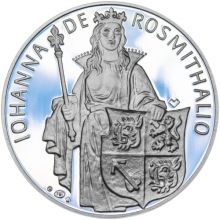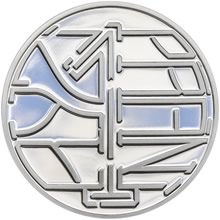PARRHASIUS (Greek). A Painter of ancient Greece, born at Ephesus; came to Athens and became the rival of Zeuxis; he was the contemporary of Socrates and a man of arrogant temper. His works were characterised by the pains bestowed on them. The design of Parrhasius representing the combats of Centaurs and Lapithae was reproduced in rilievos by the sculptor MYS on the shield of the bronze statue of Minerva, the anterior production of Pheidias. Bibliography. — C. Drury E. Fortnum, Bronzes of European origin in the South Kensington Museum, London, 1876.
Source: Biographical dictionary of medallists; coin, gem, and seal-engravers, mint-masters, ancient and modern, with references to their works B.C. 500-A.D. 1900; compiled by L. Forrer, London 1904
Source: Biographical dictionary of medallists; coin, gem, and seal-engravers, mint-masters, ancient and modern, with references to their works B.C. 500-A.D. 1900; compiled by L. Forrer, London 1904
OLIVIER, GILBERT
OLIVIER, GILBERT (French). Medallist ; son of Alexandre Olivier and Marguerite de Héry. He died in 1608, after a few months' tenure of office as " Maître garde et conducteur des engins de la monnaie du moulin de Paris". There is a record of a payment made to him in 1608 of 27 livres for Piedforts, which are probably the well-known Piedforts, dated 1607, and described in Hoffmann, Monnaies royales de France, p. 144 sqq. Pl.LXXIX sqq. : Henry IV., Al. Piedfort Ecu d'or (2 var.); — Piedfort Half E...
[ More about OLIVIER, GILBERT ]
OLIVIER, GILBERT (French). Medallist ; son of Alexandre Olivier and Marguerite de Héry. He died in 1608, after a few months' tenure of office as " Maître garde et conducteur des engins de la monnaie du moulin de Paris". There is a record of a payment made to him in 1608 of 27 livres for Piedforts, which are probably the well-known Piedforts, dated 1607, and described in Hoffmann, Monnaies royales de France, p. 144 sqq. Pl.LXXIX sqq. : Henry IV., Al. Piedfort Ecu d'or (2 var.); — Piedfort Half E...
[ More about OLIVIER, GILBERT ]
OLIVIER, RENÉ
OLIVIER, RENÉ (French). Son of Alexandre Olivier and Marguerite de Héry; Engraver at the "Monnaie des Étuves", Paris, circ. 1607 — † 1628. He was appointed " Maître ouvrier, garde et conducteur des engins de la monnaie du moulin", after the death of his brother Gilbert. In conjunction with Pierre Regnier, he signed in 1624 a petition to the State Council in opposition to Nicholas Briot. He was assassinated in Paris, 18. November 1628. Mazerolle suggests the attribution to this Engraver of the fo...
[ More about OLIVIER, RENÉ ]
OLIVIER, RENÉ (French). Son of Alexandre Olivier and Marguerite de Héry; Engraver at the "Monnaie des Étuves", Paris, circ. 1607 — † 1628. He was appointed " Maître ouvrier, garde et conducteur des engins de la monnaie du moulin", after the death of his brother Gilbert. In conjunction with Pierre Regnier, he signed in 1624 a petition to the State Council in opposition to Nicholas Briot. He was assassinated in Paris, 18. November 1628. Mazerolle suggests the attribution to this Engraver of the fo...
[ More about OLIVIER, RENÉ ]
OLRYET, FLORENTIN
OLRYET, FLORENTIN (French). Goldsmith, and Mint-engraver at Nancy, from about 1514 to 1561 . He worked for three successive Dukes of Lorraine; Anthony, Francis I., and Charles III. The first mention of his name in Mint documents occurs under date 1514/15, where it is recorded that he cut the dies fot the first gold Florin of Lorraine. B. Fillon, in his Catalogue of the Rousseau Collection, 1860, ascribed the large Portrait-thaler of Anthony (Saulcy, pl. XVI, fig. 2), Teston (Saulcy, pl. XVI, fig...
[ More about OLRYET, FLORENTIN ]
OLRYET, FLORENTIN (French). Goldsmith, and Mint-engraver at Nancy, from about 1514 to 1561 . He worked for three successive Dukes of Lorraine; Anthony, Francis I., and Charles III. The first mention of his name in Mint documents occurs under date 1514/15, where it is recorded that he cut the dies fot the first gold Florin of Lorraine. B. Fillon, in his Catalogue of the Rousseau Collection, 1860, ascribed the large Portrait-thaler of Anthony (Saulcy, pl. XVI, fig. 2), Teston (Saulcy, pl. XVI, fig...
[ More about OLRYET, FLORENTIN ]
OLYMPIOS
OLYMPIOS (Greek). Gem-engraver of the second half of the fourth century B.C. A carnelian intaglio, in the Berlin Museum, representing Eros bending his bow, bears this artist's full signature, O?YM?IO?. Furtwängler compares the remarkable type of this gem with the archers on a cup of Duris, and the figure of Ulysses on a vase of the Berlin Museum, which apparently reproduces a pictorial composition of Polygnotos. This intaglio came from Athens. Prof. Furtwängler remarks: " Obwohl dieser Künstler...
[ More about OLYMPIOS ]
OLYMPIOS (Greek). Gem-engraver of the second half of the fourth century B.C. A carnelian intaglio, in the Berlin Museum, representing Eros bending his bow, bears this artist's full signature, O?YM?IO?. Furtwängler compares the remarkable type of this gem with the archers on a cup of Duris, and the figure of Ulysses on a vase of the Berlin Museum, which apparently reproduces a pictorial composition of Polygnotos. This intaglio came from Athens. Prof. Furtwängler remarks: " Obwohl dieser Künstler...
[ More about OLYMPIOS ]



